|
Fall-Run Chinook Salmon Escapement
|
|
|
|
In order for a Chinook salmon to successfully reproduce in the Central Valley, it must survive one of the most challenging systems on the West Coast. Various factors ranging from predation, to entrainment into diversion pumps, and harvest for consumption contribute to reductions in salmon escapement. By definition, "escapement" is the portion of an anadromous fish population that escapes the commercial and recreational fisheries and reaches the freshwater spawning grounds. During the early months of the fall Chinook salmon run, many tributaries in the Central Valley have already counted more fish entering the spawning reaches this year than in the recent years since the collapse of the fishery.
San Joaquin River Basin
In the San Joaquin River basin, at the southern most end of the current Chinook salmon distribution, fall-run salmon counts are up relative to recent years. Passages recorded by a Vaki Riverwatcher fish counter at the Tuolumne River weir (1,006 as of 10/27/11) have already exceeded the total passage for 2010 of 790 salmon (Figure 1). On the Mokelumne River 2011 passages to-date recorded by video monitoring (10,944 salmon as of 10/25/11) have already exceeded the total passage for 2010 of 7,177 (Figure 2).
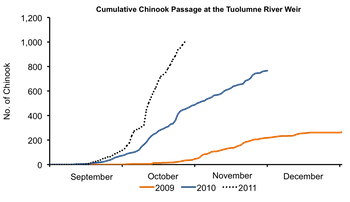
Figure 1. Daily cumulative Chinook passage at the Tuolumne River Weir, 2009-2011. |
|
|
|
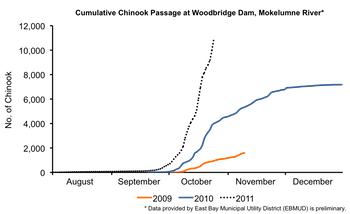
Figure 2. Daily cumulative Chinook passage at Woodbridge Dam on the Mokelumne River, 2009-2011. Sacramento River Basin In the Sacramento River basin, the escapement count on the Yuba River is up to 3,944 adult Chinook (as of 10/10/11), already exceeding last year's season total of 3,161 (Figure 3). The Battle Creek fall-run Chinook passage count is up to 24,870 (as of 10/25/11), which is already more than the total annual run size for the last four years, including 2007 when the counts reached 22,763 (Figure 4).
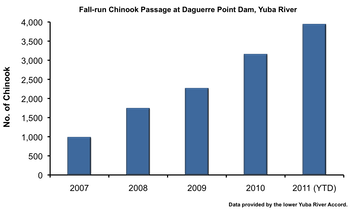
Figure 3. Annual fall-run Chinook passage at Daguerre Point Dam on the Yuba River, 2007-2011.
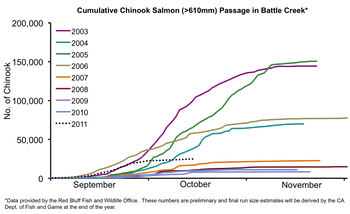
Figure 4. Daily cumulative Chinook salmon passage in Battle Creek, 2003-2011. Russian River Basin California's Russian River is within its own separate basin, but passage trends are similar to those seen in the Central Valley. Fall-run Chinook passages are counted by video monitoring at the Mirabel Rubber Dam, and total annual passage during the last couple of years has been on the rise. In 2010 total passage reached 2,414 salmon and this year (as of 10/26/11) 2,204 Chinook salmon have already been observed passing by the dam (Figure 5).
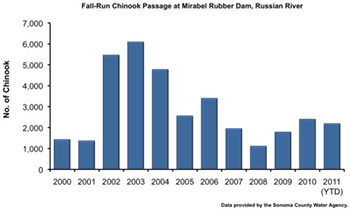
Figure 5. Annual fall-run Chinook passage at Mirabel Rubber Dam on the Russian River, 2000-2011.
Columbia River Basin Further north, at Bonneville Dam on the Columbia River, fall-run Chinook passages are on the rise and could easily match the season total from 2010 of 467,524 salmon, which exceeded the totals from the previous 5 years. This year to-date 400,064 Chinook salmon (as of 10/27/11) have been recorded passing the dam (Figure 6).
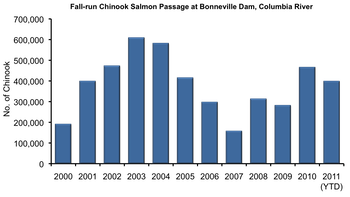
Figure 6. Annual fall-run salmon passage at Bonneville Dam on the Columbia River, 2000-2011. Although escapement is still low compared to counts in the early 2000s, before the collapse of the Central Valley fishery, this year is shaping up to be a year of decent Chinook returns across the West Coast. |
|
IN THE NEWS: Recent stories you might have missed...
|
|
Lethal virus from salmon farms seen in wild sockeye
San Francisco Chronicle
 The discovery in British Columbia of an infectious virus that has devastated salmon farms on the East Coast, in Europe and Chile has alarmed conservationists, some of whom blame the aquaculture industry, but fishery scientists say it is too early to panic. The lethal virus, infectious salmon anemia, was detected in two of the 48 wild sockeye salmon tested during a Simon Fraser University study in Rivers Inlet, on the central coast of British Columbia. Read more > The discovery in British Columbia of an infectious virus that has devastated salmon farms on the East Coast, in Europe and Chile has alarmed conservationists, some of whom blame the aquaculture industry, but fishery scientists say it is too early to panic. The lethal virus, infectious salmon anemia, was detected in two of the 48 wild sockeye salmon tested during a Simon Fraser University study in Rivers Inlet, on the central coast of British Columbia. Read more >
|
Salmon numbers rising in Sacramento-San Joaquin Delta
Fish Information & Services
 Early indicators are pointing to the success of federal salmon rebuilding plans, according to the Golden Gate Salmon Association (GGSA). Other fish dependent on the Sacramento-San Joaquin Delta are benefiting too. Rebounding fall chinook salmon numbers have brought a modest salmon season this year in California, and a poor one in Oregon. During the three previous years, fishing businesses and families faced fishing closures due to a salmon population crash... Read more > Early indicators are pointing to the success of federal salmon rebuilding plans, according to the Golden Gate Salmon Association (GGSA). Other fish dependent on the Sacramento-San Joaquin Delta are benefiting too. Rebounding fall chinook salmon numbers have brought a modest salmon season this year in California, and a poor one in Oregon. During the three previous years, fishing businesses and families faced fishing closures due to a salmon population crash... Read more >
|
|
Chinook salmon returning to Russian River in near-record numbers
Press Democrat
 Chinook salmon are coming up the Russian River to spawn in near-record numbers, signaling what may be one of the best returns of the threatened fish in a decade. "I am optimistic, but ever cautious," said Dave Manning, a principal environmental specialist for the Sonoma County Water Agency. "Until the season is over, it is difficult to say how this will stack up, but it will be above average." Read more > Chinook salmon are coming up the Russian River to spawn in near-record numbers, signaling what may be one of the best returns of the threatened fish in a decade. "I am optimistic, but ever cautious," said Dave Manning, a principal environmental specialist for the Sonoma County Water Agency. "Until the season is over, it is difficult to say how this will stack up, but it will be above average." Read more >
|
|
Blocked exit keeps salmon on coursen
Stockton Record

Imagine you drive up to a junction. Straight ahead is a long, winding one-lane road, while a six-lane freeway branches off to the left. Which way would you prefer to go? Adult chinook salmon face a similar choice each fall during their migration through the Delta, as they struggle upstream toward their place of birth on the Mokelumne River. Everything is fine until they reach an area near Walnut Grove, when they suddenly come upon an artificial side channel gushing with water. Read more >
|
|
Researchers Find Salmon Vital To Biodiversity in California
Capital Public Radio

Once California was home to a million spring run Chinook salmon. Today there are fewer than 10,000. A new study suggests climate change could render the fish extinct in California. The study also explores how important the salmon are to biodiversity. In a rowboat on Butte Creek near Chico, I'm about to plunge into chilly water to snorkel with spawning salmon. I'm accompanied by someone who has done this a lot, U.C Davis fish biologist Lisa Thompson. Read more >
|
|
|
|
|
|